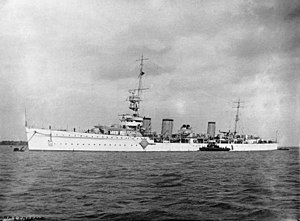Emerald-class cruiser

HMS Emerald
|
|
| Class overview | |
|---|---|
| Name: | Emerald class |
| Operators: |
|
| Preceded by: | Danae class |
| Succeeded by: | Leander class |
| In commission: | 1926–1948 |
| Planned: | 3 |
| Completed: | 2 |
| Cancelled: | 1 |
| Retired: | 2 |
| General characteristics | |
| Type: | Light cruiser |
| Displacement: |
|
| Length: | 570 ft (173.7 m) |
| Beam: | 54.5 ft (16.6 m) |
| Draught: | 16.5 ft (5.0 m) |
| Installed power: | 80,000 shp (60,000 kW) |
| Propulsion: |
|
| Speed: | 33 knots (61 km/h; 38 mph) |
| Range: |
|
| Endurance: | 1,746 tons fuel oil |
| Complement: | 572 |
| Armament: |
|
| Armour: |
|
| Aircraft carried: | 1 × aircraft (later removed) |
| Aviation facilities: | 1 × catapult (later removed) |
The Emerald class or E class was a class of two light cruisers built for the Royal Navy. Following the Cavendish class, three ships of a new class were ordered in March 1918, towards the end of World War I, designed to emphasise high speed at the cost of other qualities, for use against rumoured new high speed German cruisers - like the Brummer class - and particularly minelayers, in the North Sea. However, the third ship was cancelled in November 1918.
The E class were based on the preceding Danae class, itself based on the C-class cruiser, but had a very high ratio of length to beam and only one more gun, despite being much bigger and more expensive. Much was sacrificed to achieve 33 knots (61 km/h; 38 mph), the horsepower was doubled and the hull increased by 100 ft (30 m) in length, with a 50% increase in displacement. Only two ships were built, and completed in 1926. Four propellers were necessary for the increased power and were driven from two engine rooms. There were four boiler rooms, nos. 2 and 3 being arranged side-by-side with the exhausts trunked into a common funnel. The magazines were between boiler rooms nos. 2 and 3 and the forward engine room, and between boiler room no. 4 and the after engine room. This led to a bizarre funnel arrangement, accentuated further when in 1935 a longer catapult required the mainmast to be stepped forward of the after funnel, and the funnels were heightened by 5 ft (1.5 m).
In the early 1930s Enterprise was fitted with a prototype twin 6-inch (150 mm) turret in place of her two forward single mounts; and with trials of the turret proving successful it was retained on Enterprise for the rest of her career. The turret design was later installed in the Leander, Amphion and Arethusa classes. The turret installation occupied less space than the superimposed 'A' and 'B' guns of Emerald, therefore the bridge was placed further forward. The bridge was of a new design, being a single block topped by a director tower, rather than the traditional platforms built around the foremast and wheelhouse topped with a spotting top. This design of bridge would appear in the County-class cruisers.
...
Wikipedia
